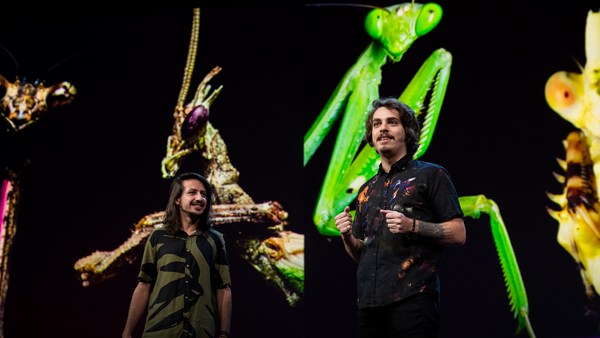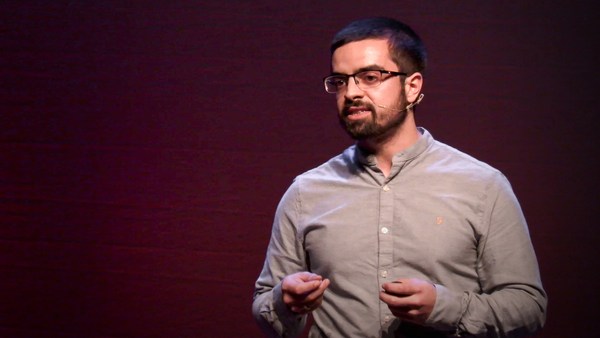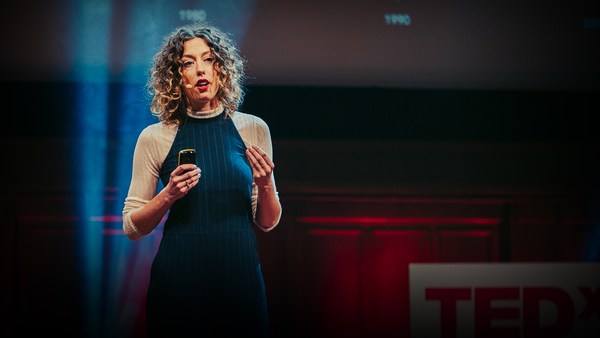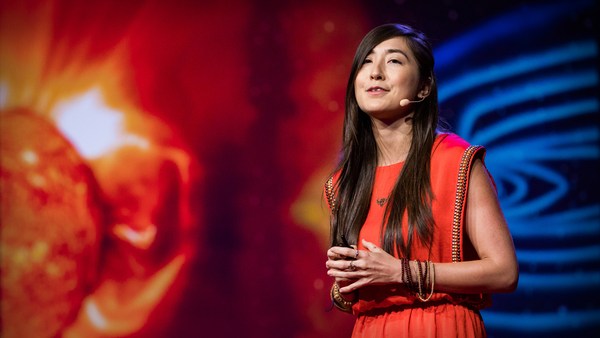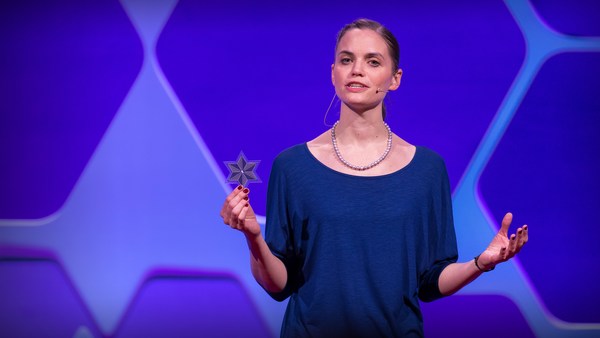I'm going to talk to you today about sea slugs and solar power. My background and what I do -- I'm an invertebrate zoologist. So invertebrate animals are animals that don't have a backbone. So this is actually most of the animals on the planet. It ranges from things like insects to clams to sea sponges to worms. And a great other many things that we don't have time to talk about today.
On our planet, most of the biological energy that we have available comes, ultimately, from the sun. The process from this being converted to solar energy, to biological energy is photosynthesis. You’re probably familiar with this as something that plants do. And all of the food that we eat ultimately comes from photosynthesis, either us directly eating plants or eating animals that eat plants. And that's really where all of the energy that all of the animals have comes from.
However, there are a few animals that have managed to get around that and become photosynthetic themselves and are able to capture the energy from the sun, convert it into biological energy, right? So just like plants, they take carbon dioxide in sunlight, turn it into sugar and oxygen.
The best and most famous example of this are the corals. The photos that we're looking at here are some some corals from the Red Sea in Egypt and from a reef in Cuba. All the photos I'm going to share with you today are photographs I've taken. And when I've gotten photos from the field, I put the location there, if you're interested. The photos from the laboratory won't be labeled like that. They have a black background on them. Corals are able to photosynthesize because of a special partnership, a symbiosis that they have with a single-celled algae called zooxanthellae. The algae live inside of cells of the coral, capture the sunlight and provide the corals with sugar. So effectively we have photosynthetic animals.
This is unusual, but actually occurs in quite a lot of the corals and many of their relatives, and actually happens in a fair number of other animals as well. So we see this in things like some sea sponges, we see this in some flatworms, and we see it in other animals closely related to corals like sea anemones and jellyfish.
So this is an upside down jellyfish. This is an organism that, just like the corals we were talking about, has these zooxanthellae inside of them and can photosynthesize. So this animal lives in like, shallow mangroves throughout the world and just lays on the bottom, capturing sunlight. I keep a few in my laboratory that I use for teaching, and I don't actually have to feed them. I just give them light from one of my aquarium lights, and I’ve managed to keep some of them there for two years. And I use them in my invertebrate zoology courses.
I like the jellyfish, though, even though the coral is perhaps a more famous example. The jellyfish is nice because we can take a tentacle of a jellyfish and look at it under the microscope, and that allows us to see this process. So this is a micrograph, a microscopic photograph I've taken, of some zooxanthellae from the tentacle of the upside-down jellyfish Cassiopeia. And I did this back at my laboratory in Tampa. And all of those little golden brown spheres that we're seeing, each one of those is one of those algal cells. So they're loaded in there quite densely. There's a lot of them there. So these animals are able to photosynthesize that way. So it's quite remarkable that we have animals that are not doing the typical animal thing. The jellyfish can still feed, and in the wild, they do. But they can get most of their energy just from the sun. Fantastic.
I primarily study a group of organisms called mollusks. Mollusks are probably familiar to some of you, if, because of nothing else, because of their shells and in some cases as food. So these include animals like snails and clams. Also things like octopus and squids and some other strange things that we won't have time to go into today. But the mollusks are a fantastically diverse group. They are the second most diverse group of animals on the planet after the arthropods, which win out because of the insects. But in terms of sheer diversity in body form, the mollusks, I would argue, are in fact the most diverse and range from things smaller than grains of rice to colossal squids that are absolutely enormous.
And we have photosynthesis within our mollusks as well. So these are giant clams. They're fantastically beautiful animals. They live in tropical coral reefs in the Indo-Pacific, primarily. And when I say giant, there's a range. Some of the species aren't quite so large, but some of them are absolutely enormous, and they’re beautiful. And a lot of the coloration we're seeing in some of these comes from their symbiotic algae. They have the same zooxanthellae that we saw within the corals. Unfortunately, giant clams are rather difficult to see in the wild. They've been overharvested in many areas because people want their large shells and they are also eaten. That's a very interesting symbiosis too.
But the group that I'm most interested in are called the gastropods. Gastropods are snails and slugs. So your typical garden snail that you may be familiar with and many of the seashells that you may have collected visiting the beach come from gastropods. So this is a tremendously diverse group of mollusks. They're the most diverse group of mollusks in terms of number of species. Quite a large number of them. And they're fantastically interesting. I wish we had time to go into more of them here. The one in the middle is a cone snail, one of the most venomous animals on the planet. And also a ... subject of a great deal of biomedical research studying the potential of its venom.
But my real passion is slugs. My favorite thing to do is go scuba diving in a tropical coral reef and look for sea slugs. And a sea slug, ultimately, or any slug, is a snail that, over the course of evolution, has lost its shell. So a slug is just a snail minus the shell, right? And this has happened multiple times. This was not a single evolutionary event, but one that occurred over and over again. And so we have multiple unrelated groups of snails that have either greatly reduced or lost their shell over the course of evolution. There's a few of them shown here, just to show you some variety. This includes the head shield slugs. There are sea hares as well as the pulmonates, or air-breathing, slugs, which may show up in your garden and cause you a great deal of displeasure.
Now, the most common question that I get when I tell people what I do for a living, studying slugs, is, “Why would you do that? Why study slugs? You could do anything. Why do that?" And I think the best way to explain this to you all is not to tell you, but to show you.
So here are some of the slugs I've encountered in my travels. They are fantastically weird. They're fantastically beautiful. They do some very strange things. There’s a lot of really interesting biology going on with these animals. And there’s so much that we don’t know. Many slugs, the only scientific paper written on them is a species description. And there's many more out there that haven't even been described. So there's so much for us to learn and so much that we don't know. It's just wide open and so fascinating to me.
Now, in the ocean, there are many types of slugs. I've sort of shown you that already. There's two groups that I'm going to tell you about now. One group is probably the most famous of them and certainly the most diverse in terms of total number of species, are the nudibranchs. And that name, “nudi,” means naked, but "branch" means gills. So it's referring to those feathery tufts that we're seeing on these animals. They're beautiful, they're diverse, they're interesting, and they're carnivores. They eat other animals, mostly -- they are slugs, right, so they’re not chasing things down. They eat other slow things. So sometimes other slugs, they also eat things like sponges and in some cases, relatives of our corals, like sea anemones. And some of these nudibranchs that do that are able to take those zooxanthellae that we were talking about earlier, put them inside of their own cells, and then they become photosynthetic. So they steal their photosynthesis. They're excellent thieves. Some of them even steal the stinging cells out of jellyfish and anemones and use them for their own defense. Absolutely fantastic.
This is my favorite group of slugs. These are the sacoglossan sea slugs. They are also thieves. They are, you may notice, green, right? Some of them are green for camouflage, but many of them are green for a very different reason. These slugs are herbivores, and they have a special single little tooth, and they just poke one little hole into the algae, and then they slurp out the contents inside of it. And they take some of those contents and they digest them. But others, the chloroplasts, which are the organelles inside of a plant cell that allows plants to photosynthesize, the slugs take those and stick them inside of their own cells, and then they become photosynthetic. We call this kleptoplasty. "Klepto", as in to steal, "plasty" as in chloroplast, right? So they've stolen chloroplasts. And these slugs, it varies, some of them can only do this for a couple of days, but some can do this for many months, even complete their entire life cycle.
Let's take a little bit closer look at the digestive track of one of these slugs. This is a photo by my colleague Nick Curtis. And this is showing us the digestive tubules of these animals. So their digestive track is highly branched. It goes in many different directions. And at the end of these branches, we have these cul de sacs that are loaded with chloroplasts. If we look closer at a single cell in one of these cul de sacs, also a photo by my colleague Nick Curtis, we see a single cell here. That's what we're looking at, that structure labeled N. That is the nucleus of the cell. But all of those structures labeled C and everything that looks like them, those circles, those are chloroplasts, and they're jammed in there so tight and so dense that there's more chloroplasts in that cell than you would find in the algae, at least in terms of density. This is wonderful. These animals have stolen photosynthesis, and you can see some of them kind of look like leafs, right? They're super green, they're fantastically photosynthetic.
And how they do this is somewhat of a mystery. Taking a chloroplast and sticking inside of a cell is not enough to become photosynthetic. Chloroplasts need things that the algae provide to them that animals shouldn’t be able to do. And we've started to unravel some of this. And this is a slow process and something that we're just really scratching the surface of. But one of the things that we've discovered for the two slugs shown here, the emerald sea slug, which can photosynthesize for its entire adult life cycle, nine months after one meal. And the lettuce sea slug, which lives throughout the Caribbean and the primary one I study, photosynthesizes three or four months after a meal. Both of these animals are able to make chlorophyll, which is one of the chemicals that is needed for photosynthesis to occur. And animals should not be able to do this. But somehow these slugs have managed to do it. And so this is one of the things that I find really exciting and that we're trying to unravel.
But there's so many things that we still don't know about this. So many questions we haven't even thought of yet to ask. What's going on here at the cellular level? What's happening at the molecular level? What's happening at the biochemical level? We're starting to get the answers to these questions. But there's so much we don't know yet. Why are some of them blue? I have no idea. But some of our slugs are occasionally this wonderful blue color, something we hope to someday figure out.
So I hope you've enjoyed this introduction to sea slugs. I hope this leaves you curious to learn more about slugs and other invertebrates. There's just so much that we don't know and so much out there for us to learn.
Thank you very much.
(Applause)
